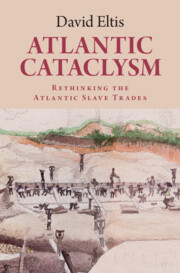Book contents
- Atlantic Cataclysm
- Atlantic Cataclysm
- Copyright page
- Epigraph
- Dedication
- Contents
- Figures
- Tables
- Maps
- Preface
- Acknowledgements
- Abbreviations
- 1 Atlantic Slave Trading and World History
- 2 The Americas and Atlantic Slave Trading: The Iberians and the Rest
- 3 Europe and Atlantic Slave Trading
- 4 The Portuguese System
- 5 Africa, Africans, and the Slave Trade
- 6 Abolition: A Leninist Interpretation
- 7 Freedom?
- Conclusion
- Index
3 - Europe and Atlantic Slave Trading
Published online by Cambridge University Press: 13 December 2024
- Atlantic Cataclysm
- Atlantic Cataclysm
- Copyright page
- Epigraph
- Dedication
- Contents
- Figures
- Tables
- Maps
- Preface
- Acknowledgements
- Abbreviations
- 1 Atlantic Slave Trading and World History
- 2 The Americas and Atlantic Slave Trading: The Iberians and the Rest
- 3 Europe and Atlantic Slave Trading
- 4 The Portuguese System
- 5 Africa, Africans, and the Slave Trade
- 6 Abolition: A Leninist Interpretation
- 7 Freedom?
- Conclusion
- Index
Summary
The Northwest Europeans were latecomers to Atlantic slavery and had to make do with second-best trading locations. It was the sixteenth- and seventeenth-century economic growth of the English and Dutch that allowed them to break into the Iberian Atlantic system rather than the two countries needing the slave trade to stimulate their economic development. Northwest Europeans never broached the Portuguese strongholds of Guinea-Bissau and Angola as slave-supply centers and were able to use Brazilian gold to hold their own in the Bight of Benin. And the British and the Dutch sold many of the slaves that they did buy to the Spanish Americas. The British made repeated unsuccessful attempts to break into the Brazilian market. The traffic was widely supported in most European countries, given that preparation for a successful voyage absorbed a large labor force and many thousands of investors.
Keywords
- Type
- Chapter
- Information
- Atlantic CataclysmRethinking the Atlantic Slave Trades, pp. 101 - 152Publisher: Cambridge University PressPrint publication year: 2025

